Filter by

A Chemical and Medical Report of the Properties of the Mineral Waters: Of Bux…
In medical terms, 'mineral water' was, in the early nineteenth century, any water that appeared to have an effect on human health. British physicians often prescribed mineral waters from particular locations - most commonly those at Bath - for a variety of illnesses. However, there was little available information on the chemical composition of these waters, and extant manuals were often inaccu…
- Edition
- -
- ISBN/ISSN
- 9781139839273
- Collation
- -
- Series Title
- -
- Call Number
- -

A Descriptive Catalogue of the Manuscripts in the Library of Eton College
M. R. James (1862–1936) is probably best remembered as a writer of chilling ghost stories, but he was an outstanding scholar of medieval literature and palaeography, who served both as Provost of King's College, Cambridge, and as Director of the Fitzwilliam Museum, and many of his stories reflect his academic background. His detailed descriptive catalogues of manuscripts owned by colleges, ca…
- Edition
- -
- ISBN/ISSN
- 9780511919916
- Collation
- -
- Series Title
- Cambridge Library Collection - History of Printing, Publishing and Libraries
- Call Number
- -

A Descriptive Catalogue of the Manuscripts in the Library of Corpus Christi C…
M. R. James (1862–1936) is probably best remembered as a writer of chilling ghost stories, but he was an outstanding scholar of medieval literature and palaeography, who served both as Provost of King's College, Cambridge, and as Director of the Fitzwilliam Museum, and many of his stories reflect his academic background. His detailed descriptive catalogues of manuscripts owned by colleges, ca…
- Edition
- -
- ISBN/ISSN
- 9780511703560
- Collation
- -
- Series Title
- Cambridge Library Collection - History of Printing, Publishing and Libraries
- Call Number
- -

A Descriptive Catalogue of the Manuscripts in the Fitzwilliam Museum
M. R. James (1862–1936) is probably best remembered as a writer of chilling ghost stories, but he was an outstanding scholar of medieval literature and palaeography, who served both as Provost of King's College, Cambridge, and as Director of the Fitzwilliam Museum, and many of his stories reflect his academic background. His detailed descriptive catalogues of manuscripts owned by colleges, ca…
- Edition
- -
- ISBN/ISSN
- 9780511693830
- Collation
- -
- Series Title
- Cambridge Library Collection - History of Printing, Publishing and Libraries
- Call Number
- -
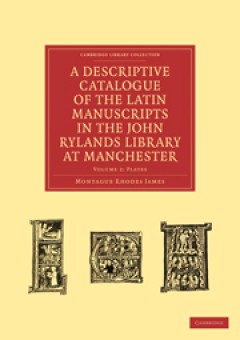
Get access
M. R. James (1862–1936), best known as a writer of chilling ghost stories, was an outstanding scholar of medieval literature and palaeography, who served both as Provost of King's College, Cambridge, and as Director of the Fitzwilliam Museum. His detailed descriptive catalogues of manuscripts owned by colleges, cathedrals and museums are still of value to scholars today. This two-volume catal…
- Edition
- -
- ISBN/ISSN
- 9780511919930
- Collation
- -
- Series Title
- Cambridge Library Collection - History of Printing, Publishing and Libraries
- Call Number
- -
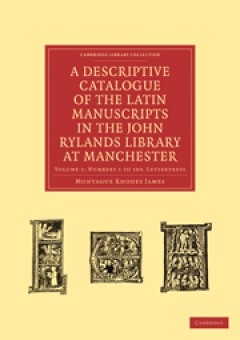
A Descriptive Catalogue of the Latin Manuscripts in the John Rylands Library …
M. R. James (1862–1936), best known as a writer of chilling ghost stories, was an outstanding scholar of medieval literature and palaeography, who served both as Provost of King's College, Cambridge, and as Director of the Fitzwilliam Museum. His detailed descriptive catalogues of manuscripts owned by colleges, cathedrals and museums are still of value to scholars today. This two-volume catal…
- Edition
- -
- ISBN/ISSN
- 9780511919930
- Collation
- -
- Series Title
- Cambridge Library Collection - History of Printing, Publishing and Libraries
- Call Number
- -
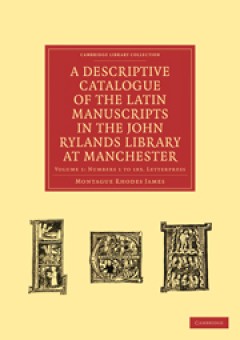
A Descriptive Catalogue of the Latin Manuscripts in the John Rylands Library …
M. R. James (1862–1936), best known as a writer of chilling ghost stories, was an outstanding scholar of medieval literature and palaeography, who served both as Provost of King's College, Cambridge, and as Director of the Fitzwilliam Museum. His detailed descriptive catalogues of manuscripts owned by colleges, cathedrals and museums are still of value to scholars today. This two-volume catal…
- Edition
- -
- ISBN/ISSN
- 9780511919923
- Collation
- -
- Series Title
- Cambridge Library Collection - History of Printing, Publishing and Libraries
- Call Number
- -
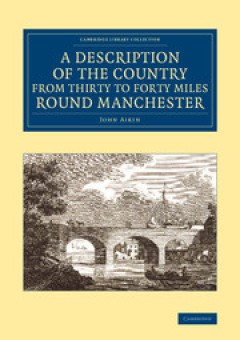
A Description of the Country from Thirty to Forty Miles round Manchester
The late eighteenth century saw Manchester and its surrounding areas undergo significant change as industrialisation fuelled urbanisation and population growth. In this classic 1795 account, the physician and prolific writer John Aikin (1747–1822) gathers together information on the settlements at the heart of manufacturing and trade in north-west England, covering the vital network of waterw…
- Edition
- -
- ISBN/ISSN
- 9781107706101
- Collation
- -
- Series Title
- Cambridge Library Collection - British & Irish History, 17th & 18th Centuries
- Call Number
- -

A Description of Patagonia, and the Adjoining Parts of South America
Thomas Falkner (1707–84), one-time pupil of both Richard Mead and Isaac Newton, was an English Jesuit missionary who lived for nearly forty years in South America until 1767, when he returned to England following the Jesuits' expulsion from Córdoba. Originally published in 1774 in the hope that it 'might be of some public utility, and might also afford some amusement to the curious', this is…
- Edition
- -
- ISBN/ISSN
- 9781139775472
- Collation
- -
- Series Title
- Cambridge Library Collection - Latin American Studies
- Call Number
- -
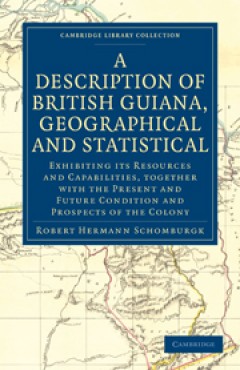
A Description of British Guiana, Geographical and Statistical
Sir Robert Hermann Schomburgk (1804–1865) was a German-born surveyor and traveller. In 1835–1839 he explored British Guiana for the Royal Geographical Society. In 1840 he was appointed to define its boundaries with Brazil, as Brazilian encroachments were wiping out native tribes. His report to the Colonial Office was published as A Description of British Guiana, Geographical and Statistical…
- Edition
- -
- ISBN/ISSN
- 9780511783586
- Collation
- -
- Series Title
- Cambridge Library Collection - Latin American Studies
- Call Number
- -
 Computer Science, Information & General Works
Computer Science, Information & General Works  Philosophy & Psychology
Philosophy & Psychology  Religion
Religion  Social Sciences
Social Sciences  Language
Language  Pure Science
Pure Science  Applied Sciences
Applied Sciences  Art & Recreation
Art & Recreation  Literature
Literature  History & Geography
History & Geography